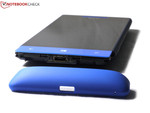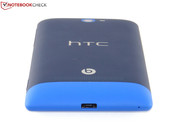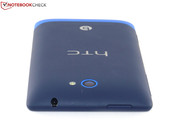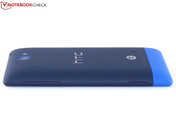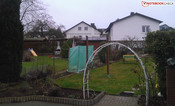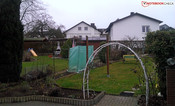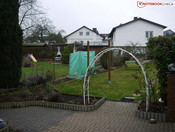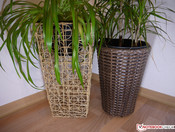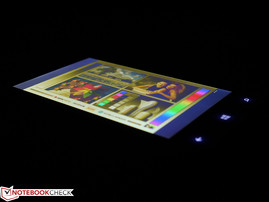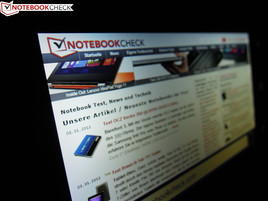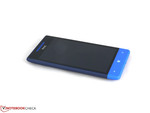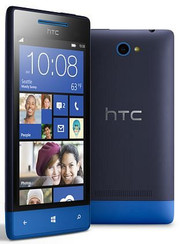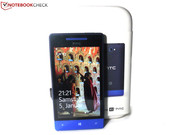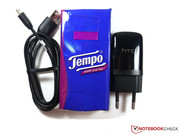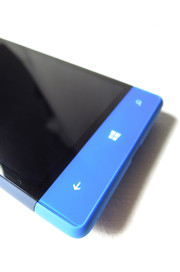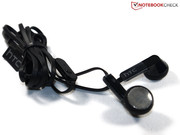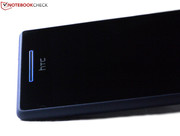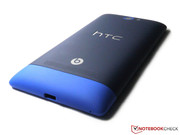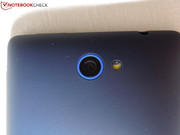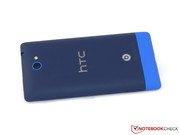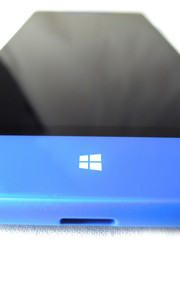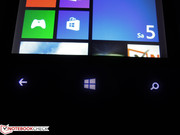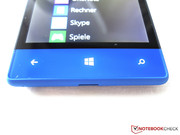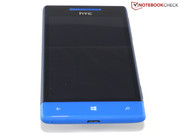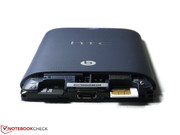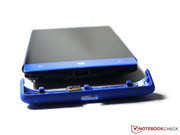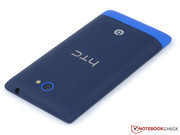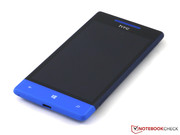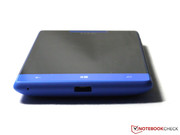Review HTC Windows Phone 8S Smartphone

For the original German review, see here.
Like the Windows Phone 8X the 8S is a reference device from Microsoft to present the Windows-Phone-8 operating system. While the 8X addressed smartphone enthusiasts the HTC 8S wants to reach mainstream customers. To lower the price, adjustments to the hardware were necessary. The processor only runs at 1 instead of 1.5 GHz, the memory was cut in half and the display size shrunk from 4.3 to 4 inches. The result is a 200 Euro ($266) lower price. The Windows Phone 8S by HTC is therefore the entry for Microsoft’s new smartphone operating system and has to compete with midrange Android smartphones. But can the midrange smartphone with Windows Phone 8 OS convince?
Case
A special feature of the Windows Phone 8S is the different case colors which always consist of two colors. Available case colors are Domino, High-Rise Gray Yellow, Fiesta Red and Atlantic Blue from our review sample. Below the display are capacitive buttons whose background is either colored light or bright. The detachable cover on the back gives access to the micro SIM and micro SD card slot and also continues the color scheme. The rest of the case consists of one piece of polycarbonate in a subtle color under which the built-in battery is located. Despite the lack of an aluminum case the 8S does not feel cheap. Thanks to HTC's proven Unibody-design the build quality and the stability of the smartphone are good.
The plastic case also enables a lightweight design. The review sample with its battery only weighs 113 grams (~0.25 pounds). Furthermore the back is rubberized and the edges are heavily rounded. As a result the 8S lies comfortably in the hand and avoids slipping out of the hand at the same time. With dimensions of 10.3 x 63 x 120.5 millimeters (~0.41 x 2.48 x 4.74 inches) handling the device with one hand is possible. The physical buttons for Standby, Volume and Camera are to be evaluated negatively. The smartphone buttons don’t stick out very much and can hardly be felt, but after a few days you memorize the position. Unfortunately the undefined actuating point of the Standby-button remains. The lack of a distinct feedback is the reason you press the button more often and immediately lock the display again.
Features
Software
The operating system is Windows Phone 8. In our review of the Windows Phone 8X we already took a close look at Microsoft’s latest smartphone OS. HTC just slightly modified the user interface, for example the implementation of the tile color based on the color of the device itself into the OS. The number of preinstalled applications from HTC is very small. HTC Hub is one of these applications and gives a quick overview of the weather, stocks and news. The applications Connection Setup and Make More Space are quite useless in contrast. While the former configures mobile network settings, Make More Space gives you advice on storage management. The map material is now provided by Nokia instead of Bing. The navigation option with speech commands we know from Lumia devices is not available, instead the directions are displayed as text.
Some inconsistencies remain with Windows Phone 8. In some applications the status bar is hidden so the time, for instance, is not shown when you are browsing the web. Furthermore there are only three manual brightness settings (low, medium, high), but if you activate the option "auto brightness" the display dims more than in the "low" setting.
Communication & GPS
The communication with a wireless router can be established with the standards 802.11 b/g/n. Additionally, pictures and videos can wirelessly be transferred to DLNA enabled devices. Contact to peripherals and other smartphones is available over Bluetooth 3.1. Near Field Communication (NFC) is not included.
For the journey to the World Wide Web on the road HSPA is available. Up to 14.4 Mbit/s download and up to 5.76 Mbit/s upload is possible.
The current location can be determined with A-GPS and Glonass. Thanks to the simultaneous use of both location systems the connection to the satellites is fast.
Telephony
The default view of the phone application is the call list. After pushing the little button "Keypad" a numerical keyboard appears from the bottom where you can enter a number. An auto fill has not been integrated.
Cameras & Multimedia
The back camera has an aperture ratio of f2.8 and a 5 megapixels sensor. It is a 35 mm lens and you can use the LED flash in dark environments. With low battery the flash cannot be used anymore to take a picture. Videos can be recorded in the small HD mode (720p). The 8S was not treated with a front facing camera for video calls or self-portraits.
The image quality of the Windows Phone 8S cannot convince: colors are presented too pale and the whole picture is slightly bluish. Small details are lost due to the small sensor. HTC didn't implement any special features such as continuous shooting. Of course, the camera of the Windows Phone 8S cannot keep up with a system camera or even a DSLR. But even the image quality of cheap compact cameras cannot be reached. You shouldn't trust the 5 megapixels camera with holiday pictures, but it works fine as a snapshot camera.
The preinstalled application Photo Enhancer applies effects and image optimizations to pictures, like the software Instagramm. However, additional details cannot be made visible from initial pictures with a lack of detail.
Accessories
The small and stylish box contains, besides the smartphone and a modular power supply unit, a multi-language documentation, the manual on a mini-CD and a headset with a 3.5 mm audio jack. HTC offers optional accessories in its own online shop, among them the hardcover HC C820, which is available in the same colors as the smartphone itself.
Warranty
The warranty period is 24 months. A warranty upgrade is not offered by HTC, but there are numerous warranty extensions available in online shops or electronics centers.
Games
The graphic calculations are handled by the Qualcomm Adreno 305 GPU. The performance is below the older Adreno 225 GPU, but none of the tested games could bring the HTC 8S to its knees. However we have to admit that the selection of performance demanding games in the Windows Phone Store is still limited and these are even playable on older Windows Phone devices.
Input Devices & Controls
The capacitive touchscreen reacts quickly and accurately to input. Multi-touch gestures work as reliably as navigating through the menus. The four row QWERTZ keyboard is automatically shown in both the profile and the landscape mode. In the landscape mode the virtual keyboard seems a bit small yet there is available space on both sides. However, the buttons are bigger than they are in the profile mode and the typo ratio is quite small. The auto fill of the keyboard also works very reliably and all in all allows fast typing.
Display
The 4-inch screen of the Windows Phone 8S has a resolution of WVGA (800x480 pixels) and presents up to 16.7 million colors. The pixel density calculates to 233 dpi and is the reason why texts and pictures are not displayed razor-sharp. The Super-LCD is protected by Corning Gorilla Glass which should prevent scratches for the most part.
With the Gossen Mavo-monitor we measure a maximum brightness of 355 cd/m² in the lower left corner. The average is a good 331 cd/m², which leads to a brightness distribution of 88%. This puts the 8S slightly ahead of the more expensive Windows Phone 8 smartphones Nokia Lumia 920 (322 cd/m²) and Windows Phone 8X (294 cd/m²). The leader remains the Apple iPhone 5 with an average 487 cd/m².
| |||||||||||||||||||||||||
Brightness Distribution: 88 %
Center on Battery: 333 cd/m²
Contrast: 812:1 (Black: 0.41 cd/m²)
Despite the absence of a display with IPS-technology the 8S offers a good black rate of 0.41 cd/m², which results in a contrast ratio of 812:1. Colors appear rich, but not oversaturated.
During outdoor use the user benefits from the high contrast and the good brightness. Use under clear skies is therefore not a problem. Only under direct sunlight reflections complicate the readability of the screen content.
The heart of the Windows Phone 8S is an SoC by Qualcomm based on the Krait architecture. The integrated 1 GHz dual-core CPU called Qualcomm Snapdragon S4 MSM8227 is similar to the Cortex-A15 architecture and therefore superior to the Cortex-A9 processors. Alongside the CPU are the Adreno 305 GPU and 512 MB RAM. The system meets the minimum requirements for Windows Phone 8.
The user interface works snappy most of the time but has to deal with some occasional lags. Especially while typing it becomes noticeable when the pop-up keyboard does not appear at times or the typed characters appear with a 1-2 second delay. The rendering of websites with the default browser Internet Explorer 10 is also slow. When the page is completely loaded there is no lagging or reloading. If you additionally want to switch between other applications like OneNote or MS Office the application has to reload again. The memory seems to have already reached its limit at this point.
For the comparison of Windows Phone smartphones we use the benchmarks Multibench 2 and WP Bench free. The Multibench test splits up into the four categories CPU: 11.378, Data: 15.012, Memory: 1.822 and Graphics: 33.998. In all categories it is clearly beaten by the Windows Phone 8X, the WP Bench free is with 233.5 to 179.94 points in favor of the 8X as well.
Because of the still relatively new platform there are no established benchmarks and cross-platform benchmarks are also still rare. A first step in this direction is made by the AnTuTu benchmark that is familiar to Android devices. There our review sample reaches 7332 points and is slightly ahead of the HTC One S with better hardware and Android OS. The Windows Phone 8X - with the same hardware as the One S - pulls ahead by 67%. The enormous performance difference is therefore caused by the operating system.
The browser based benchmarks show a clear picture: in Browsermark 2.0 and Peacekeeper the Windows Phone 8S can position itself ahead of the rival Galaxy S3 mini by 33% and 24%. Only the JavaScript benchmarks Sunspider and Google V8 are in contradiction. While the HTC 8S takes the lead in the Sunspider benchmark, the Google V8 favors the S3 mini.
| Browsermark - --- (sort by value) | |
| HTC Windows Phone 8S | |
| Samsung S3 Mini GT-I8190 | |
| Google Nexus 4 | |
| Google V8 Ver. 7 - Google V8 Ver. 7 Score (sort by value) | |
| HTC Windows Phone 8S | |
| Samsung S3 Mini GT-I8190 | |
| HTC Windows Phone 8X | |
| Google Nexus 4 | |
| Sunspider - 0.9.1 Total Score (sort by value) | |
| HTC Windows Phone 8S | |
| Samsung S3 Mini GT-I8190 | |
| HTC Windows Phone 8X | |
| Google Nexus 4 | |
| AnTuTu v2 - Total Score (sort by value) | |
| HTC Windows Phone 8S | |
| HTC Windows Phone 8X | |
* ... smaller is better
Voice Quality
The caller was clearly understandable and there were no complaints about distortions or unusual sounds on the other side. Only some background noise was mentioned by the caller. When using the included headset there were no distortions except the background noise.
Emissions
Temperature
The temperature development of the Windows Phone 8S remains in a suitable area. At idle we measured a maximum of 31.2 °C (88.16 °F) at the capacitive buttons with the Voltcraft IR-350. During maximum load the temperature rises above 40 °C (104 °F) in several spots. You can clearly feel the warming up but it does not get uncomfortable even with longer use.
(±) The maximum temperature on the upper side is 41 °C / 106 F, compared to the average of 35.2 °C / 95 F, ranging from 21.9 to 247 °C for the class Smartphone.
(±) The bottom heats up to a maximum of 41.1 °C / 106 F, compared to the average of 34 °C / 93 F
(+) In idle usage, the average temperature for the upper side is 28.6 °C / 83 F, compared to the device average of 32.9 °C / 91 F.
Speaker
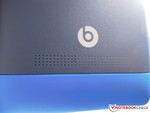
The HTC 8S has only one speaker, located on the back. However the earpiece is not active. The sound is not convincing, trebles are too pronounced and the bass is too weak. The maximum volume is not very high but it still blasted and produced distortions.
The writing Beats Audio on the back does not apply for the speaker. Beats Audio is just software that gets activated with attached headphones. When you plug the headphones in Beats Audio is instantly available. The headphones are only standard quality and produce a slight acoustic noise. The volume however is more than convincing. Bass comes across with the headphones but it sounds a bit tinny.
Energy Management
Power Consumption
Compared to other 4-inch smartphones like the Samsung Galaxy S3 mini or the Apple iPhone 5, the HTC 8S turns out to be considerably more power hungry. This problem might be caused by the Windows operating system since both the Lumia 920 and the HTC 8X show higher power consumption. At idle the Voltcraft VC 940 measures 1.2-2.6 Watts, where the S3 mini with 0.7-1.2 Watts is considerably more frugal. Even at maximum load the S3 mini consumes less power with 2.4 Watts. The Windows Phone 8S by contrast uses 4.1 Watts.
| Off / Standby | |
| Idle | |
| Load |
|
Key:
min: | |
Battery Runtime
The maximum battery runtime is determined with minimum brightness (setting low) and constantly activated energy-saving mode. The energy-saving mode prevents multitasking, so background tasks are paused. In the foreground a script refreshes pages of a text document in the browser. In this scenario the device shuts down just after 15 hours. Without the energy-saving mode it is only 12 hours and 46 minutes. The very opposite is determined with the help of the application WP Bench free which utilizes the device to its full capacity. All wireless connections are activated and the display brightness is set to maximum. After 2 hours and 47 minutes the device runs out of power. Both tests show two very rare scenarios. A more common scenario is estimated with surfing with WLAN that utilizes a script to refresh a website every 40 seconds. For the brightness we use the Windows option "medium" which corresponds to a value of 117 cd/m² and therefore cannot be compared to our other smartphone reviews (~150 cd/m²). The energy-saving mode is now activated when the remaining battery capacity is below 20%. More than 8 hours elapse to full discharge.
A repeated charging of the 1700 mAh battery is finished after only 2 hours and 21 minutes when the device is turned on. The Windows Phone 8S does not have to hide from competitors, it offers a solid battery runtime in all scenarios.
Verdict
For currently 260 Euros (~$346) HTC brings an entry-level smartphone for smartphone newcomer and switching users to the market with the Windows Phone 8S. In this review we especially liked the case with its solid appearance yet low weight and compact dimensions. The performance convinced us as well, however there were some lags from time to time. The small amount of available memory has a negative impact and limits the multitasking.
Among others the Samsung Galaxy S3 mini comes to mind as a competitor from the Android camp. It offers better battery runtime but cannot score with its outdoor use ability due to the low screen brightness. The latest Google Smartphone Nexus 4 can also be seen as an alternative. It is packed with power and offers a bigger screen with HD resolution.
If you want to use Windows Phone 8 as an OS the options are currently very limited. A true alternative for supporters of the tile-based operating system is currently Nokia with the Lumia 620 and Huawei with the Ascend W1. If you dig a little deeper in your pockets the more powerful devices Nokia Lumia 920 and HTC Windows Phone 8X are also worth consideration.





